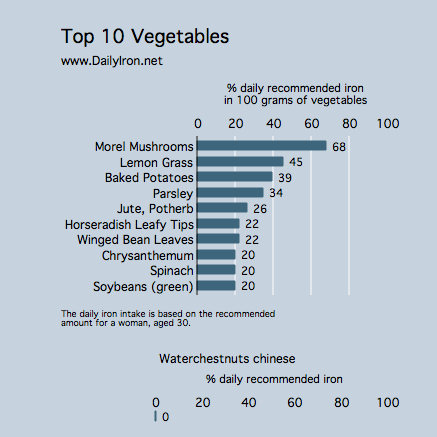Waterchestnuts contain .05 milligrams of iron per 100 grams. Grams is a measure of weight. To put 100 grams in perspective, consider alternative measures for this food:
- .5 cup equals 62 grams.
- 4 waterchestnuts equals 36 grams.
In the category of vegetables, we included whole vegetable products in the Top 10 list. We excluded dried/dehydrated products from the Top 10. You will find some dehydrated vegetables high in iron pbut they tend to be far more volume than anyone would consume. Furthermore, foods may be fortified with iron but are not included in this Top 10 list. The food tested for the particular graph below can be described more specifically as:
Waterchestnuts, chinese, (matai), raw
Read more about iron in vegetables or visit our iron-rich foods list.

Vegetables for the most part are not an exceptional source of iron. Those vegetables that are packed with iron also are likely to be high in iron inhibitors and so you may not absorb a large amount of iron from the vegetables.
Nonetheless, even a vegetable with minimal iron may play a valuable role in your iron metabolism. Vegetables can often be a good source of vitamin C, a vitamin that will help you take up the iron in your plant-based foods; Chinese waterchestnuts (matai) are a meager source of vitamin C.
Still, as an example you can combine peppers and tomatoes with a whole grain main dish or with legumes to increase your absorption of the iron in your whole meal. A raw pineapple dessert with a meal would also improve your iron metabolism because of the fruit’s content of vitamin C. A glass of fruit juice is yet another an outstanding plan.